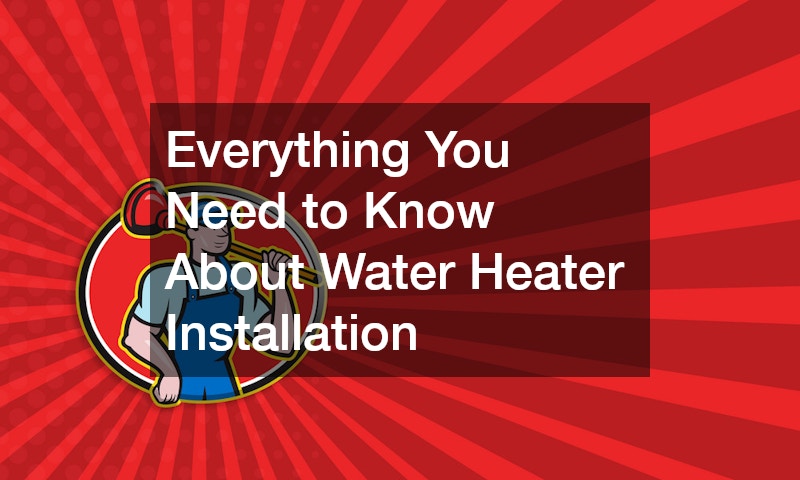Everything You Need to Know About Water Heater Installation
In this comprehensive guide, we will explore everything you need to know about water heater installation. Whether you’re replacing an old unit or installing one for the first time, understanding the process and requirements is crucial for ensuring efficiency and safety. Choosing the right water heater can significantly affect energy consumption and utility costs over time, making it essential to make informed decisions.
How do I Choose the Right Water Heater for My Home?
Understanding Different Types of Water Heaters
There are several types of water heaters, each offering unique benefits and efficiencies. Conventional storage water heaters are perhaps the most common, storing a set volume of hot water that is ready for use. Tankless water heaters, on the other hand, provide hot water on demand, which can lead to energy savings as they do not maintain a reserve of hot water.
Heat pump water heaters are another option, functioning by transferring heat from the air to heat the water, thus being highly energy-efficient. Solar water heaters utilize solar panels to heat water, minimizing electricity usage and reducing carbon footprint. It is important to evaluate the availability of space and energy sources in your home when choosing a type of water heater.
Calculating the Required Capacity
Calculating the required capacity of your water heater is essential for meeting your household’s hot water needs efficiently. Start by estimating your household’s peak hot water demand, considering factors such as the number of family members and usage patterns. A larger family with simultaneous demands for showers and laundry will require a higher-capacity water heater.
For a conventional storage water heater, capacity is measured in gallons, whereas tankless systems use flow rates, typically in gallons per minute (GPM). It is important to choose a water heater that can accommodate peak usage without running out of hot water. Oversized units can lead to unnecessary energy consumption, while undersized ones may not provide adequate hot water.
Evaluating Energy Efficiency
Energy efficiency is a vital consideration when selecting a water heater, as it impacts both environmental footprint and utility expenses. Check the Energy Factor (EF) or Uniform Energy Factor (UEF) ratings; higher ratings signify better efficiency and potential energy savings. Energy-efficient models often qualify for rebates or tax incentives, further offsetting initial purchase costs.
Heat pumps and solar water heaters are among the most energy-efficient, although the relative efficiency depends on installation location and climate. Incorporating energy-saving technology can further enhance efficiency, such as using smart thermostats or insulative jackets for storage heaters. Energy efficiency also translates to fewer greenhouse gas emissions, contributing to environmental conservation.
What are the Steps for Installing a Water Heater?
Preparation and Safety Measures
Proper preparation is critical for a successful installation, starting with ensuring all safety measures are in place. Turn off the power and water supply to the existing water heater to prevent accidents. Gather the necessary tools and materials, and ensure you have adequate workspace for installation.
Read the manufacturer’s instructions carefully, as requirements may vary between different models and types of water heaters. Check for local codes and permits that might be required before installation begins. Safety measures, such as wearing protective gear and ensuring adequate ventilation, are crucial in preventing injuries during the installation process.
Installation Process
The installation process for a water heater typically involves several key steps, from positioning the unit to making the necessary connections. Start by installing any required fittings and positioning the heater in a suitable location, ensuring it meets clearance requirements. Connect the water supply lines, ensuring there are no leaks by using new hoses and Teflon tape on threaded joints.
For electric units, connect the power supply according to the manufacturer’s instructions, ensuring all connections are secure and free from corrosion. Gas water heaters require careful connections of the gas line and venting system; a professional might be recommended if you’re unfamiliar with gas installations. Once all connections are secure, fill the tank with water and check for leaks again.
Post-Installation Checklist
After installation, it is important to perform a comprehensive post-installation checklist to ensure everything is functioning correctly. Check for leaks in all connections by inspecting them visually and listening for any drips or unusual noises. Ensure the system is properly vented; improper ventilation can lead to dangerous gases building up in the home.
In conclusion, knowledge is key to achieving a successful water heater installation. Following this guide will help you navigate through the complexities, allowing you to tackle this home improvement project with confidence. Investing time and effort in proper installation today will repay you with efficient and effective performance in the future.
“
.

